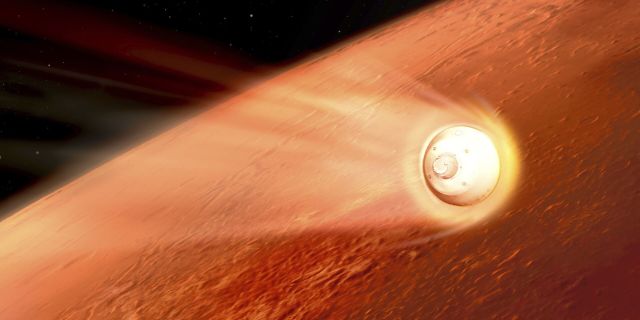Chinese rover finds signs of catastrophic floodsThe Chinese rover Zhuzhong has detected signs of two major floods on the Red Planet, the British scientific journal Nature reports.
Scientists suggest that they could form the entire southern part of the Utopia Plain, which experts have been studying since 2021.
Smriti Mallapati (Smriti Mallapaty)The data obtained is the key to the history of an almost unexplored region.
The Chinese rover "Zhuzhong" (Zhurong) looked deep under the surface of the Red Planet and found signs of two major floods.
They could form the entire region that scientists have been exploring since its landing in May 2021.
The analysis, published today in the journal Nature, provides the first data from the Zhuzhong radar thermal imager, which reaches a depth of up to 100 meters. "This is a very interesting work, and it impressed me especially how deeply this radar allows you to see," said Svein—Erik Hamran, a planetary scientist from the University of Oslo, comparing them with the only previously available data collected by NASA's Perseverance rover.
The landing site of the Zhuzhong, a vast lowland in the northern hemisphere called the Utopia Plain, has long been of interest to scientists. Some have suggested that the area was once formed by water or ice. Observations from space have revealed sedimentary deposits — a sign that the region could once have been an ancient ocean or gone under water as a result of a huge flood. In addition, some geological features of the area — in particular, the pit cones — resemble structures formed by water or ice. In May, researchers analyzed infrared images of the landing site from the Chinese Tianwen-1 orbiter and found hydrated minerals that could have formed as a result of rising groundwater or melting ice.
But the region could also be covered by lava, which hid part of the hydrological processes underground. An eruption of the Elysium volcano to the east of the landing site or any other could cover the area with magma — as it was in other parts of the Utopia basin. According to the radar data, the researchers hope to restore the course of events and find out whether water or ice could have been preserved under the stones. "We want to know what's going on below the surface," says Liu Yang, a planetary scientist at the National Space Science Center in Beijing and co—author of the study.
At depthZhuzhong, the first Chinese all-terrain vehicle on the Red Planet, explores the southern part of the Utopia Plain.
The rover's underground radar transmits high-frequency radio waves that penetrate below the surface to a depth of three to ten meters, and low-frequency ones that reach a depth of up to 100 meters, but have a lower resolution. The authors of the study analyzed low-frequency data obtained from May 25 to September 6 for over 1.1 thousand meters, when the Zhuzhong was moving south from the landing site. Radar signals are reflected from rocks below the surface, showing their size and texture, as well as the ability to retain an electric charge. The more powerful the signal, the larger, as a rule, the object.
The radar did not detect any traces of liquid water at a depth of up to 80 meters — but it found two horizontal layers with an interesting structure. The team reports that in a reservoir from ten to 30 meters deep, the reflected signals are amplified with increasing depth. Researchers have suggested that this may be due to the fact that it is based on larger boulders, and smaller stones on top. An older and deeper layer at a depth of 30 to 80 meters gave a similar picture.
The older layer could have appeared as a result of a rapid flood that occurred more than three billion years ago during an era of high water activity and brought sediments to this region, says study co-author Chen Lin, a seismologist from the Institute of Geology and Geophysics at the Chinese Academy of Sciences in Beijing.
The upper layer could have formed during another flood about 1.6 billion years ago as a result of high glacial activity. Chen believes it is unlikely that the lava flows have been preserved intact in it — otherwise this layer would have held an electric charge better. In addition, the researchers did not see sudden deformations of the stratification, which are formed when lava flows collide with sedimentary material.
Volcanic or sedimentary?At the same time, it is quite possible, says Chen, that the upper layer once covered a thin layer of lava, but gradually split into smaller pieces.
However, according to the radar data alone, it is impossible to definitively determine the origin — sedimentary or volcanic, says Xu Yi, a planetary scientist from the Macau University of Science and Technology.
According to Hamran, radar data reflects the layering and geometry of the subsurface material well, but they are not suitable for accurate determination of the composition and cannot accurately determine whether the rock is under us or ice. He noted that in order to restore the picture of events, scientists often look for other clues — for example, looking out of the surface of the rock. The authors of the study do not exclude the possibility that underground salt ice remained in the region.
It is expected that in the future it will be possible to obtain more radar data, including during the movement of the Zhuzhong on the surface of Mars, and also correlate them with the high—frequency measurements and orbital observations already made from the board of the Tianwen interplanetary station. This will help clarify the nature of the landscape. "This is just the first step," Chen Ling concluded.

